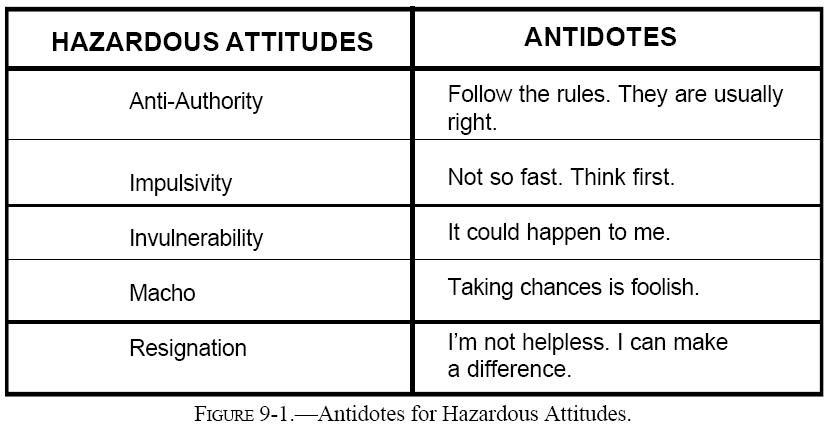|
EFFECTIVENESS OF ADM
The effectiveness of ADM and the safety of general
aviation depend on several factors:
• The knowledge required to understand the
situation, the information available, and the possible
options.
• The skills required to execute a decision.
• Understanding how to make decisions effectively,
including how to search for information and when to
stop searching and choose a course of action.
• The self-awareness to recognize when hazardous
attitudes are influencing decisions and possessing the
self-discipline to overcome those attitudes.
The first two factors, knowledge and skills, will be
addressed during ground and flight training. The
knowledge required to understand weather conditions,
use of checklists, and other items required for flight
planning will be explained. An authorized instructor
also teaches how to put preflight planning into action.
This starts a pilot on a path toward making good
aeronautical decisions based on the limitations of the
aircraft, weather conditions, and the pilot's experience
level. This also helps a pilot develop a positive
attitude toward safety and risk management. Having
a positive attitude means always considering the
potential safety implications of decisions.
Progressive decision making recognizes that changes
are constantly taking place, and that a pilot should be
continually assessing the outcome. For example, more
weather information allows the pilot to judge the
quality of the decision and to recognize when it is
time to modify that outcome in the face of new
information. A pilot with this progressive decision
making strategy may make changes rapidly based on
the information at hand. The pilot should continue to
seek more information about the situation so the plan
may be refined and modified if necessary.
Flexibility and the capability to modify actions as new
information is obtained are very desirable features
of decision making. What this means, in simplest
terms, is always having a way out.
The other factor that was mentioned earlier that would
affect the quality and safety of a pilot's decisions is
attitude. Attitude is one of those aspects of human
nature that is hard to define precisely, but we know it
when we see it. It is an overall approach to life. It is
something in the way people talk and act that makes
us think that they are reckless, safe, liberal,
conservative, serious, happy-go-lucky, or any one of
a number of other adjectives. They have a certain style
of responding to life's events that is relatively
consistent and which they tend to apply in many
situations.
Think for a moment about the stereotypical image of
pilots portrayed in popular films particularly those
from several years ago. Films deal in images and an
image like that is much easier to portray than the reality.
There is a lot of truth to the old adage, "There are old
pilots and there are bold pilots, but there are no old,
bold pilots." Flying is a wondrous adventure, but it is
not the place for boldness, thrill seeking, complacence,
or lack of dedication to doing the best one can.
A series of studies conducted a few years ago
identified five attitudes among pilots that were
particularly hazardous. These attitudes are:
• Antiauthority This attitude is found in people
who do not like anyone telling them what to do. Flying
is governed by many regulations established for the
safety of all, so pilots with this hazardous attitude
may rebel against authority by deliberately breaking
rules intended for safety.
• Impulsivity This is the attitude of people who
frequently feel the need to do something anything
immediately. They do the first thing that comes to mind,
without thinking about what the best alternative might
be.
• Invulnerability Many people feel that accidents
happen to others, but never to them. They know
accidents can happen, and they know that anyone can
be affected, but they never really feel or believe they
will be personally involved. A pilot with this attitude
is more likely to take chances and increase risk.
• Macho A pilot who is always trying to prove
that he or she is better than anyone else is thinking, "I
can do it I'll show them." All pilots are equally
susceptible to this hazardous attitude which can lead
to taking risks to impress others.
• Resignation Pilots who think, "What's the
use?" do not see themselves as being able to make a
great deal of difference in what happens. They blame
whatever happens on luck. Instead of seeking out
information and making positive decisions, they just
drift along making no changes and hoping for the best.
Having these attitudes can contribute to poor pilot
judgment, since they tend to push the pilot toward
making decisions that involve more risk. Recognizing
that these hazardous attitudes exist is the first step in
neutralizing them in the decision making process.
Before dismissing these attitudes as belonging to
someone else, realize that everyone has these attitudes
to some degree. At one time or another all pilots have
acted impulsively or in a macho fashion to demonstrate
their aviation skills to others.
Pilots should be aware of these attitudes and constantly
examine their actions to see if they are falling prey to
their influences. This helps a pilot improve the quality
of his or her actions.
Developing good decision making skills allows pilots
to fly securely in the knowledge that they are
controlling risk and ensuring safety. Figure 9-1
provides some useful antidotes for hazardous attitudes.

|

